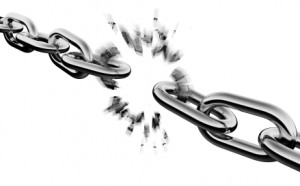Brand Linkage
Brand linkage fail: “Saw a great ad – don’t remember who it’s for –”
Maybe you were convinced that yes, you’d like to have that automatic braking in your car so you won’t back over the charming toddler on the tricycle, but what car model was that again? Brand linkage failures (by definition) occur when the marketing benefits the category in general, but not the particular brand.
Brand linkage breakdowns are more painful (and more expensive) than other marketing shipwrecks. To illustrate why, let’s look at three categories of wasted effort and busted budgets. 
Failure Category One: Benefit Salad. Turn on your tv, and observe the efforts of local advertisers. Or open that envelope that arrived from a would-be vendor. You won’t have to wait long before someone gives you a sermon about how they will give you quality service selection price blah blah blah. They throw every possible benefit at you in hopes that one sticks. Or that their 10 Reasons Why will sweep you away. Note that you remain unswept.
Failure Category Two: The Impotent Claim. So, successful marketing should showcase one single differentiator to separate your brand from competitors. That’s fundamental blocking and tackling. Once you get visible, get differentiated. It falls apart, however, when the claim is one that multiple brands make. We’ve written before about brands that make feeble attempts to “own” customer service. It’s incredible because e-v-e-r-y-o-n-e claims it, including all your competitors. Besides that enormous hurdle, every prospect expects perfect service as a birthright, and will ask what else you got, pal?
But let’s go beyond the amateur hour of shouting car dealers and item-and-price retailers. Let’s tune in to bigger, more costly failures in prime time, including:
Failure Category Three: Brand Linkage, unlinked. We step up now to the kind of big-dollar disaster when marketers get almost everything right. They recognize the customer’s needs, the non-rational basis of persuasion, the need to dramatize the story in ways that surprise and delight us. Unfortunately…
The well-told story might engage our attention, show us the giddy joys of making the right choice or the dismal consequences of making the wrong choice. It can even be water-cooler talk the next day. And yet? And yet? The message let our “right” brand slip from memory, or, worse yet, summon up the name of a competitor. We’ve all shared the experience: at the moment, I’m trying without success to remember the brand of heartburn remedy that shows food slapping people as they try to bite it. Interesting imagery, but whose?
In our experience, a disdain for effective branding is to blame. When a creative team falls in love with technique or production values or colorful storytelling, visions of award shows take over. This imbalance between art and commerce is avoidable, since great marketing can, must, effectively link the narrative to the brand identity. Creativity works best when anchored by strategy.